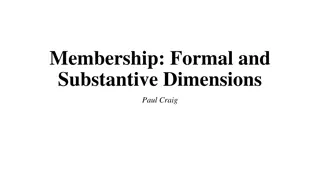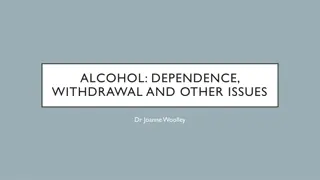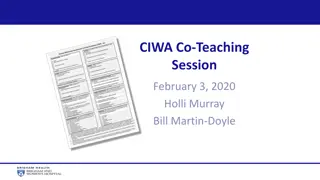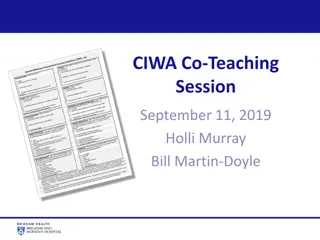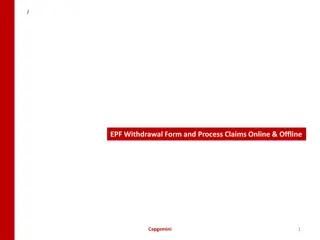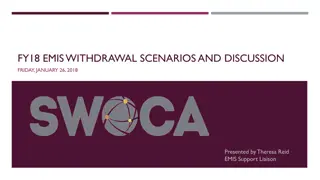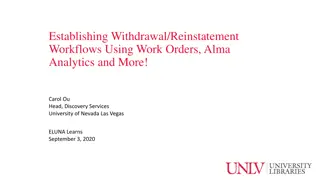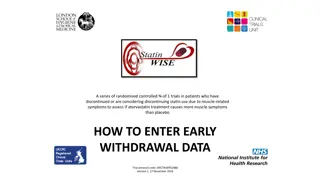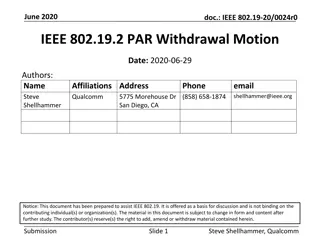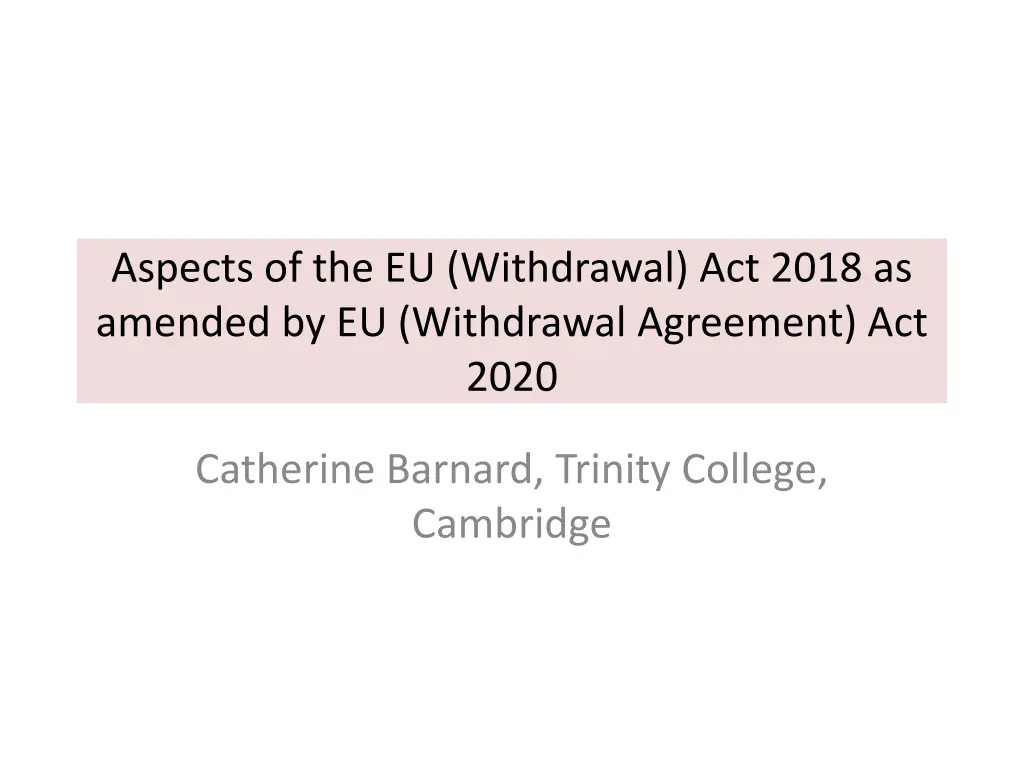
EU Withdrawal Act 2018: Aspects & Direct Effects
Explore the aspects of the EU Withdrawal Act 2018 as amended by the EU Withdrawal Agreement Act 2020, including its application during transition, in areas covered by the WA 2020, and post-transition direct effects. Understand the direct effect of EU law provisions, treaty provisions, and the transition process under the European Communities Act 1972.
Download Presentation

Please find below an Image/Link to download the presentation.
The content on the website is provided AS IS for your information and personal use only. It may not be sold, licensed, or shared on other websites without obtaining consent from the author. If you encounter any issues during the download, it is possible that the publisher has removed the file from their server.
You are allowed to download the files provided on this website for personal or commercial use, subject to the condition that they are used lawfully. All files are the property of their respective owners.
The content on the website is provided AS IS for your information and personal use only. It may not be sold, licensed, or shared on other websites without obtaining consent from the author.
E N D
Presentation Transcript
Aspects of the EU (Withdrawal) Act 2018 as amended by EU (Withdrawal Agreement) Act 2020 Catherine Barnard, Trinity College, Cambridge
The Timetable and the Phases Nov 2018/Oct 2019 Political declaration Withdrawal agreement concluded EU(WA) Act 2020 29 Mar 2019/31 Oct 2019/31 Jan 2020 Leave EU Part 4 WA 1 Feb 2020 Start of plans for negs for future deal Transition starts (IP) Extension of transition Fisheries [74] Equivalence financial services [36] Key date in negotiations 31 Dec 2020/or 1 or 2 years later -Ratification? -UK impl. legislation Transition ends 1 Jan 2021? But what if not agreed? NI Protocol Future trade deal starts
What it is Its application during transition Its application in those areas covered by the WA 2020 Its application post transition DIRECT EFFECT
Direct effect of EU law provisions Treaty provisions mainly vertical direct effect (eg Arts. 34, 110 TFEU on goods); Some full horizontal direct effect (eg Art. 45 TFEU: Max Planck, Art. 157 TFEU: Defrenne) Directives Vertical direct effect only but broad definition of state Foster, Farrell (no horizontal direct effect: Cisco) General principles Horizontal (dis)application (direct effect?) (Mangold) Charter Horizontal (dis)application (direct effect?) (Egenberger, Bauer) State Vertical direct effect Individual Individual horizontal direct effect
Transition s.2(1) ECA All such rights, powers, liabilities, obligations and restrictions from time to time created or arising by or under the Treaties, and all such remedies and procedures from time to time provided for by or under the Treaties, as in accordance with the Treaties are without further enactment to be given legal effect or used in the United Kingdom shall be recognised and available in law, and be enforced, allowed and followed accordingly; and the expression enforceable EU right and similar expressions shall be read as referring to one to which this subsection applies. s.1A EU(W)A 2018 (introduced by s1 EU(WA)A 2020) The European Communities Act 1972, as it has effect in domestic law or the law of a relevant territory immediately before exit day, continues to have effect in domestic law or the law of the relevant territory on and after exit day so far as provided by subsections (3) to (5)
Art. 4 Withdrawal Agreement ARTICLE 4 Methods and principles relating to the effect, the implementation and the application of this Agreement 1.The provisions of this Agreement and the provisions of Union law made applicable by this Agreement shall produce in respect of and in the United Kingdom the same legal effects as those which they produce within the Union and its Member States. Accordingly, legal or natural persons shall in particular be able to rely directly on the provisions contained or referred to in this Agreement which meet the conditions for direct effect under Union law. 2.The United Kingdom shall ensure compliance with paragraph 1, including as regards the required powers of its judicial and administrative authorities to disapply inconsistent or incompatible domestic provisions, through domestic primary legislation
7AGeneral implementation of remainder of withdrawal agreement (1)Subsection (2) applies to (a)all such rights, powers, liabilities, obligations and restrictions from time to time created or arising by or under the withdrawal agreement, and (b)all such remedies and procedures from time to time provided for by or under the withdrawal agreement, as in accordance with the withdrawal agreement are without further enactment to be given legal effect or used in the United Kingdom. (2)The rights, powers, liabilities, obligations, restrictions, remedies and procedures concerned are to be (a)recognised and available in domestic law, and (b)enforced, allowed and followed accordingly. (3)Every enactment (including an enactment contained in this Act) is to be read and has effect subject to subsection (2). (4)This section does not apply in relation to Part 4 of the withdrawal agreement so far as section 2(1) of the European Communities Act 1972 applies in relation to that Part. (5)See also (among other things)- (a)Part 3 of the European Union (Withdrawal Agreement) Act 2020 (further provision about citizens rights), (b)section 20 of that Act (financial provision), (c)section 7C of this Act (interpretation of law relating to withdrawal agreement etc.), (d)section 8B of this Act (power in connection with certain other separation issues), (e)section 8C of this Act (power in connection with the Protocol on Ireland/Northern Ireland in withdrawal agreement), and (f)Parts 1B and 1C of Schedule 2 to this Act (powers involving devolved authorities in connection with certain other separation issues and the Ireland/Northern Ireland Protocol).
Retained EU law Retained EU law Preserved legislation or EU-derived domestic legislation Converted legislation Other primary and secondary leg with the same purpose as regs under s.2(2) Direct EU legislation as it applies with adaptations to the EEA Directly effective Treaty rights Other domestic legislation Regs under s.2(2) ECA Direct EU legislation EU regulations EU decisions EU tertiary legislation s. 2 saves this legislation and carries it over s. 4 converts this s. 3 converts this into domestic law
s. 4(1) Primary EU law Treaties Any rights, powers, liabilities...recognised under s.2(1) ECA continue on or after exit day to be recognised and available Art. 5(2) supremacy continues Directly effective rights in Treaties that can be relied on directly in court by an individual will continue eg Art. 157 but how? Backstop? Constitutional check? Possible re pre-Brexit law [p.18] But always subject to Section 7
Section 4: directly effective Treaty provisions Treaty provision substance Treaty provision substance Art. 18 Non-discrimination Art. 102 Abuse of dom position Art. 20 (not 20(2)(c) EU citizenship Art. 106(1) and (2) Public undertakings Art. 21(1) F.M of EU citizens Art. 107(1) State aid Art. 28 Customs Union Art. 108(3) Comm consideration of plans Art. 30 Prohibition of customs duties Art. 110 Internal tax Art. 34 F.m of goods (imports) Art. 111-113 Non-discrim re internal taxes Art. 35 F.m of goods (exports) Arts. 120-6 Ec cooperation Art. 36 exceptions Art. 157 Equal pay Art. 37(1) and (2) Prohibition of discrimination re conditions under which goods procured Art 308 (first and second sub paras) EIB Art. 45(1), (2) and (3) f.m of workers Art. 325 (1) and (2) Combatting fraud on the EU Art. 49 establishment Art. 346 Disclosure of info and national security Art. 56 Freedom to provide services Various articles of Prot. 5 EIB Art. 63 f.m of capital Prot 7 Art. 21 Privileges and immunities of the EIB Art. 101(1) competition
But many are turned off Eg SI 2019/1401The Freedom of Establishment and Free Movement of Services (EU Exit) Regulations 2019 3. (1) Any rights, powers, liabilities, obligations, restrictions, remedies and procedures which (a)continue by virtue of section 4(1) of the European Union (Withdrawal) Act 2018; and (b)are derived (directly or indirectly) from (i)Articles 56 and 57 of the Treaty on the Functioning of the European Union; cease to be recognised and available in domestic law (and to be enforced, allowed and followed accordingly). (2) But the cessation of the rights, powers, liabilities, obligations, restrictions, remedies and procedures set out at paragraph (1)(b)(iii) and (iv) does not apply to any matter which falls within the interpretation, application or operation of the Immigration Acts.
Directives S.2(1) and s.2(2) EU(W)A 2018 Carries across preserved or EU derived legislation (eg Working Time Regs) s. 4(2) EU(W)A 2018 Incorrectly implemented/non- implemented Directives
Section 4(2)(b) Subsection (1) does not apply to any rights so far as they arise under an EU Directive and are not of a kind recognised by the European Court or any court or tribunal in the UK in a case decided before exit day (whether or not as an essential part of the deciosn in the case) Directly effective provisions of Directives carried across but only if recognised as directly effective by Brexit day Serendipity? Does that specific provision need to have been recognised as DE? Vertical DE only? Two versions of norm which trumps?
General principles of law Schedule 1, Para. 3 There is no right of action in domestic law on or after exit day based on a failure to comply with any GP of EU law. No court or tribunal may on or after Brexit day disapply or quash any enactment or rule of law So no Mangold, Kucuckdeveci, AMS, Ajos
Sched 1, para. 4: Rule in Francovich What is the rule in Francovich? Largely a stepping stone case Why name the case Brasserie du Pecheur/Factortame III better What is being removed? Horizontal situations? Courage v Creehan
Benkharbouche [2017] UKSC 62 The scope of article 47 of the Charter is not identical to that of article 6 of the Human Rights Convention, but the Secretary of State accepts that on the facts of this case if the Convention is violated, so is the Charter. .. It follows that there is no separate issue as to article 47 of the Charter. The only difference that it makes is that a conflict between EU law and English domestic law must be resolved in favour of the former, and the latter must be disapplied; whereas the remedy in the case of inconsistency with article 6 of the Human Rights Convention is a declaration of incompatibility.
The Charter and EU (Withdrawal) Act 2018 S 5(4) The Charter of Fundamental Rights is not part of domestic law on or after exit day. s 5(5)Subsection (4) does not affect the retention in domestic law on or after exit day in accordance with this Act of any fundamental rights or principles which exist irrespective of the Charter. (and references to the Charter in any case law are, so far as necessary for this purpose, to be read as if they were references to any corresponding retained fundamental rights or principles).
The General Principles: Sched I Para.2 Only GPs recognised before Brexit apply to the UK Para.3(1) No right of action in domestic law on or after Brexit day based on failure to comply with GPs Demise of Mangold
Legacy of the Charter I: ECJ All pre-Brexit case law of the Court of Justice (retained EU case law) handed down prior to Brexit day will continue to be binding on UK courts and tribunals. S. 6(7) of the EU (Withdrawal) Act provides that retained EU case law means any principles laid down by, and any decisions of, the European Court, as they have effect in EU law immediately before exit day . Binding like decision of the SCt/High Ct of Judiciary(s 6(4)(a) and (b)) SCt/High Ct of Judiciary can depart from retained EU case law, applying same test used to depart from own case law (s6(5))
Role of the Court of Justice Post Brexit UK cts not bound by any decisions of ECJ (s 6(1)(a)) BUT may have regard to anything done on or after Brexit day by the European Court so far as is relevant to any matter before the court or tribunal (Callanan amendment) (s 6(2))
Legacy effect of the Charter II: Quashing the validity of EU law Para 3(2) No court or tribunal or other public authority may, on or after exit day (a) disapply or quash any enactment or other rule of law, or (b) quash any conduct or otherwise decide that it is unlawful, because it is incompatible with any of the general principles of EU law.
Walker v Innospec He argued that the UK rules contravened the Framework Directive 2000/43. SCt interpreted the Framework Directive in line with the background case law (the case law which continues post exit since it was decided prior to exit day) and general principles of EU law. Under s.5(2) EU(W) Act 2018, EU-derived law has supremacy post exit day to and can be used to disapply legislation enacted prior to exit day (and legislation enacted prior to exit day that is modified post exit day if there is the intention that this legislation should still be subject to EU law). EU-derived law has been interpreted in line with general principles. This re-interpreted law is then used to disapply some provisions in Acts of Parliament.





